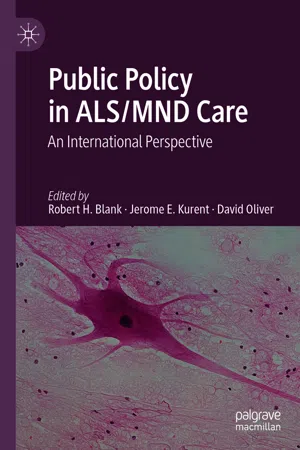Introduction
Incurable progressive neurological disorders cause immense pain and suffering for their victims and their families. The associated huge economic and indirect costs to society are often difficult to calculate. A rapidly growing aging population in many regions of the world is strongly associated with the increased incidence of neurodegenerative disease and has major public policy implications. Amyotrophic lateral sclerosis/motor neuron disease (ALS/MND) may be the prime example of a devastating rapidly progressive neurodegenerative disease for which there is no cure or significant disease-modifying therapy. Although there are three approved drugs used for the treatment of ALS/MND, their benefits are limited, and most other treatment options are limited primarily to symptom management.
There is a clear need for effective public policy and research focused on ensuring optimal clinical care of patients with ALS/MND and provision of adequate supportive services. Increased research funding focused on an enhanced understanding of the etiology(ies) and pathophysiology of ALS/MND and mechanisms of motor neuron cell death is expected to lead to development of additional disease-modifying agents and ultimately to a cure. There is also the potential that insights gained from the study of ALS/MND may provide clues to other enigmatic neurodegenerative diseases, including dementia, that plague our societies.
A primary goal of this book is to develop a compendium of public policy summaries representative of many different countries across the globe. It discusses a range of ALS/MND policy elements and perspectives while providing a framework for understanding ALS/MND as it affects patients and their families, professional caregivers and researchers. The book should be of interest to those involved in health care policy and public health as well as for ALS clinicians including neurologists, nurses, nurse practitioners, allied health professionals and physicians’ assistants involved in the complex range of issues related to ALS/MND. Additional stakeholders who should find this book of interest include social workers, ALS clinic coordinators and administrators and members of ALS and MND private foundations and public agencies dedicated to the optimum treatment of patients with ALS/MND—including the goal of its ultimate defeat. The book may also serve as a useful reference for organizations providing durable medical equipment such as wheelchairs, communication devices, beds and other assistive equipment utilized in the management of patients with progressive disability.
What Is ALS/MND?
ALS is a progressive fatal neuromuscular disease first described by Charcot in 1869 which primarily affects spinal cord and brainstem motor neurons and the upper motor neuron system. ALS may be regarded as a syndrome rather than a specific disease entity. There is increasing evidence of wider neuronal involvement, including the frontal lobes, and cortical and subcortical regions (Westeneng et al. 2016). ALS is also known as Lou Gehrig’s disease in the United States, named after the famous major league baseball player who succumbed to this illness in 1941, whereas in the United Kingdom, motor neuron disease is used to designate ALS. Within the classification ICD-9 (code 335.2), the term motor neuron disease is also indistinguishable from ALS. It has been suggested that the term motor neuron diseases be used to include both ALS and its clinical subtypes. Thus, ALS/MND as used here encompasses:
- ALS/MND, with both upper and lower motor neuron involvement, leading to a mixed picture of weakness associated with spasticity and flaccidity, muscle wasting, fasciculation and extensor plantar responses; average longevity three to five years; more than 90 percent of people with limb onset develop bulbar symptoms;
- Progressive bulbar palsy affects about 20 percent of patients in which there is involvement of the bulbar motor neurons, affecting speech and swallowing;
- Progressive muscular atrophy (PMA) affects about 5 percent, with predominantly lower motor neuron involvement leading to muscular weakness and wasting, particularly of the legs and arms. The prognosis is longer and may be five to ten years;
- Primary lateral sclerosis (PLS) which affects 1–2 percent with predominantly upper motor neuron involvement, including spasticity, stiffness, increased deep tendon reflexes and extensor plantar response. It has a longer prognosis often greater than ten years
The most common clinical presentation of ALS/MND is spinal-onset and involves slowly progressive painless weakness and atrophy of a distal upper or lower extremity. Weakness typically progresses to involve the contralateral limb and then to other areas of the body including bulbar and respiratory muscles. Rarely—less than 5 percent—do patients first present with respiratory failure that requires ventilator support. The average age of onset is 55 to 57 years, with a male to female ratio of 1.7:1, except 1:1 having onset after 65 to 70 years of age. Death typically occurs within three to five years from respiratory muscle failure, although 25 percent of patients survive for five years and 10 percent are alive at ten years (Shaw et al. 2014).
Frontotemporal dementia (FTD) occurs in up to 15 percent of patients (McKhann et al. 2001). More subtle frontal lobe dysfunction may occur in another 20 to 25 percent of patients (Lomen-Hoerth et al. 2003; Strong et al. 2009; Phukan 2012). There are patients with FTD who later develop ALS/MND with a spectrum from pure ALS to pure FTD—often related to the C9orf72 genetic abnormality (Couratier et al. 2017). An estimated 90 to 95 percent of patients have sporadic ALS (sALS) which occurs in the absence of a clear family history. Five to 10 percent of ALS patients have familial ALS (fALS) usually inherited as a Mendelian autosomal dominant gene. Reduced penetrance is not uncommon.
Making the Diagnosis of ALS/MND: A Diagnosis of Exclusion
The neurologist must take a careful history and perform a meticulous neurological examination to determine if an alternative cause of the patient’s symptoms can be identified. Depending on localizing signs and symptoms, MRI imaging of the spine is often necessary to rule out structural lesions, such as cervical or lumbar stenosis, herniated disc with foraminal encroachment and spinal cord compression, meningioma and other spinal cord pathology. Although there are no specific biomarkers currently available to confirm ...
